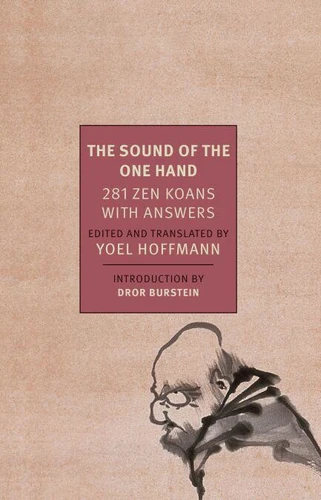The Sound of the One Hand. 281 Zen Koans with Answers
Par : , ,Formats :
Disponible dans votre compte client Decitre ou Furet du Nord dès validation de votre commande. Le format ePub protégé est :
- Compatible avec une lecture sur My Vivlio (smartphone, tablette, ordinateur)
- Compatible avec une lecture sur liseuses Vivlio
- Pour les liseuses autres que Vivlio, vous devez utiliser le logiciel Adobe Digital Edition. Non compatible avec la lecture sur les liseuses Kindle, Remarkable et Sony
- Non compatible avec un achat hors France métropolitaine
 , qui est-ce ?
, qui est-ce ?Notre partenaire de plateforme de lecture numérique où vous retrouverez l'ensemble de vos ebooks gratuitement
Pour en savoir plus sur nos ebooks, consultez notre aide en ligne ici
- Nombre de pages304
- FormatePub
- ISBN978-1-68137-023-1
- EAN9781681370231
- Date de parution06/12/2016
- Protection num.Adobe DRM
- Taille3 Mo
- Infos supplémentairesepub
- ÉditeurNYRB Classics
Résumé
The celebrated and controversial Zen Buddhist text on koans and their elusive answers, now updated for new readers"For scholars and students of Zen, inquiring readers, or anyone seeking relief from the rhetoric of division in the current political sphere, The Sound of the One Hand offers helpful didacticisms and poetic reflections that are truly timeless." -Nozomi Saito, AsymptoteWhen The Sound of the One Hand came out in Japan in 1916 it caused a scandal.
Zen was a secretive practice, its wisdom relayed from master to novice in strictest privacy. That a handbook existed recording not only the riddling koans that are central to Zen teaching but also detailing the answers to them seemed to mark Zen as rote, not revelatory. For all that, The Sound of the One Hand opens the door to Zen like no other book. Including koans that go back to the master who first brought the koan teaching method from China to Japan in the 18th century, this text offers, in the words of the translator, editor, and Zen initiate Yoel Hoffmann, "the clearest, most detailed, and most correct picture of Zen" that can be found.
What we have here is an extraordinary introduction to Zen thought as lived thought, a treasury of problems, paradoxes, and performance that will appeal to artists, writers, and philosophers as well as Buddhists and students of religion.
Zen was a secretive practice, its wisdom relayed from master to novice in strictest privacy. That a handbook existed recording not only the riddling koans that are central to Zen teaching but also detailing the answers to them seemed to mark Zen as rote, not revelatory. For all that, The Sound of the One Hand opens the door to Zen like no other book. Including koans that go back to the master who first brought the koan teaching method from China to Japan in the 18th century, this text offers, in the words of the translator, editor, and Zen initiate Yoel Hoffmann, "the clearest, most detailed, and most correct picture of Zen" that can be found.
What we have here is an extraordinary introduction to Zen thought as lived thought, a treasury of problems, paradoxes, and performance that will appeal to artists, writers, and philosophers as well as Buddhists and students of religion.
The celebrated and controversial Zen Buddhist text on koans and their elusive answers, now updated for new readers"For scholars and students of Zen, inquiring readers, or anyone seeking relief from the rhetoric of division in the current political sphere, The Sound of the One Hand offers helpful didacticisms and poetic reflections that are truly timeless." -Nozomi Saito, AsymptoteWhen The Sound of the One Hand came out in Japan in 1916 it caused a scandal.
Zen was a secretive practice, its wisdom relayed from master to novice in strictest privacy. That a handbook existed recording not only the riddling koans that are central to Zen teaching but also detailing the answers to them seemed to mark Zen as rote, not revelatory. For all that, The Sound of the One Hand opens the door to Zen like no other book. Including koans that go back to the master who first brought the koan teaching method from China to Japan in the 18th century, this text offers, in the words of the translator, editor, and Zen initiate Yoel Hoffmann, "the clearest, most detailed, and most correct picture of Zen" that can be found.
What we have here is an extraordinary introduction to Zen thought as lived thought, a treasury of problems, paradoxes, and performance that will appeal to artists, writers, and philosophers as well as Buddhists and students of religion.
Zen was a secretive practice, its wisdom relayed from master to novice in strictest privacy. That a handbook existed recording not only the riddling koans that are central to Zen teaching but also detailing the answers to them seemed to mark Zen as rote, not revelatory. For all that, The Sound of the One Hand opens the door to Zen like no other book. Including koans that go back to the master who first brought the koan teaching method from China to Japan in the 18th century, this text offers, in the words of the translator, editor, and Zen initiate Yoel Hoffmann, "the clearest, most detailed, and most correct picture of Zen" that can be found.
What we have here is an extraordinary introduction to Zen thought as lived thought, a treasury of problems, paradoxes, and performance that will appeal to artists, writers, and philosophers as well as Buddhists and students of religion.



